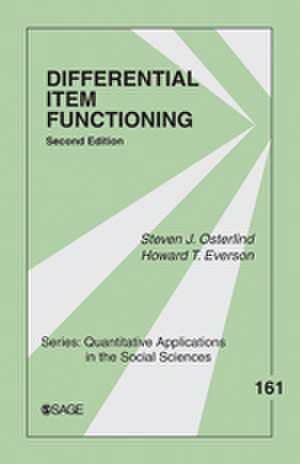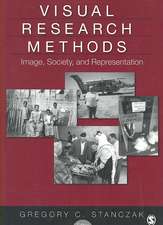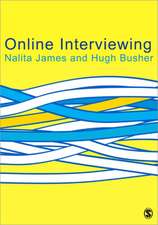Differential Item Functioning: Quantitative Applications in the Social Sciences, cartea 161
Autor Steven J. Osterlind, Howard T. Eversonen Limba Engleză Paperback – 7 dec 2009
This text is ideal for the measurement professional or advanced student who deals with educational or psychological assessment. Readers need only have a preliminary background in tests and measurement, including some beginning statistics and elementary algebra, in order to find this volume useful.
Din seria Quantitative Applications in the Social Sciences
-
 Preț: 323.09 lei
Preț: 323.09 lei -
 Preț: 285.10 lei
Preț: 285.10 lei -
 Preț: 285.33 lei
Preț: 285.33 lei -
 Preț: 274.06 lei
Preț: 274.06 lei -
 Preț: 285.37 lei
Preț: 285.37 lei -
 Preț: 321.52 lei
Preț: 321.52 lei -
 Preț: 330.81 lei
Preț: 330.81 lei -
 Preț: 322.61 lei
Preț: 322.61 lei -
 Preț: 321.79 lei
Preț: 321.79 lei -
 Preț: 323.15 lei
Preț: 323.15 lei -
 Preț: 273.46 lei
Preț: 273.46 lei -
 Preț: 275.42 lei
Preț: 275.42 lei -
 Preț: 277.33 lei
Preț: 277.33 lei -
 Preț: 322.06 lei
Preț: 322.06 lei -
 Preț: 286.18 lei
Preț: 286.18 lei -
 Preț: 285.71 lei
Preț: 285.71 lei -
 Preț: 322.06 lei
Preț: 322.06 lei -
 Preț: 321.52 lei
Preț: 321.52 lei -
 Preț: 322.30 lei
Preț: 322.30 lei -
 Preț: 285.47 lei
Preț: 285.47 lei -
 Preț: 322.61 lei
Preț: 322.61 lei -
 Preț: 321.79 lei
Preț: 321.79 lei -
 Preț: 323.15 lei
Preț: 323.15 lei -
 Preț: 323.36 lei
Preț: 323.36 lei -
 Preț: 322.41 lei
Preț: 322.41 lei -
 Preț: 323.42 lei
Preț: 323.42 lei -
 Preț: 322.61 lei
Preț: 322.61 lei -
 Preț: 284.99 lei
Preț: 284.99 lei -
 Preț: 285.47 lei
Preț: 285.47 lei -
 Preț: 284.99 lei
Preț: 284.99 lei -
 Preț: 289.18 lei
Preț: 289.18 lei -
 Preț: 287.82 lei
Preț: 287.82 lei -
 Preț: 316.12 lei
Preț: 316.12 lei -
 Preț: 288.96 lei
Preț: 288.96 lei -
 Preț: 316.71 lei
Preț: 316.71 lei -
 Preț: 314.98 lei
Preț: 314.98 lei -
 Preț: 317.26 lei
Preț: 317.26 lei -
 Preț: 314.60 lei
Preț: 314.60 lei -
 Preț: 289.95 lei
Preț: 289.95 lei -
 Preț: 289.18 lei
Preț: 289.18 lei -
 Preț: 315.36 lei
Preț: 315.36 lei -
 Preț: 314.98 lei
Preț: 314.98 lei -
 Preț: 314.38 lei
Preț: 314.38 lei -
 Preț: 316.33 lei
Preț: 316.33 lei -
 Preț: 316.51 lei
Preț: 316.51 lei -
 Preț: 314.76 lei
Preț: 314.76 lei -
 Preț: 288.41 lei
Preț: 288.41 lei -
 Preț: 316.51 lei
Preț: 316.51 lei
Preț: 314.60 lei
Nou
Puncte Express: 472
Preț estimativ în valută:
60.20€ • 64.37$ • 50.19£
60.20€ • 64.37$ • 50.19£
Carte tipărită la comandă
Livrare economică 18 aprilie-02 mai
Preluare comenzi: 021 569.72.76
Specificații
ISBN-13: 9781412954945
ISBN-10: 1412954940
Pagini: 104
Dimensiuni: 140 x 216 x 10 mm
Greutate: 0.09 kg
Ediția:Second Edition
Editura: SAGE Publications
Colecția Sage Publications, Inc
Seria Quantitative Applications in the Social Sciences
Locul publicării:Thousand Oaks, United States
ISBN-10: 1412954940
Pagini: 104
Dimensiuni: 140 x 216 x 10 mm
Greutate: 0.09 kg
Ediția:Second Edition
Editura: SAGE Publications
Colecția Sage Publications, Inc
Seria Quantitative Applications in the Social Sciences
Locul publicării:Thousand Oaks, United States
Cuprins
About the Authors
Series Editor's Introduction
1. Introduction
2. Description of DIF
3. Statistical Facets of DIF
4. Important Considerations
5. History of Test Bias and DIF
6. Quick-But-Incomplete Methods
7. Mantel-Haenszel Procedure
8. Nonparametic Methods
9. IRT-Based Methods
10. Logistic Regression
11. Specialized DIF Procedures
12. Future Directions
Conclusion
References
Author Index
Subject Index
Series Editor's Introduction
1. Introduction
2. Description of DIF
3. Statistical Facets of DIF
4. Important Considerations
5. History of Test Bias and DIF
6. Quick-But-Incomplete Methods
7. Mantel-Haenszel Procedure
8. Nonparametic Methods
9. IRT-Based Methods
10. Logistic Regression
11. Specialized DIF Procedures
12. Future Directions
Conclusion
References
Author Index
Subject Index
Notă biografică
Dr. Steven J. Osterlind is Professor of Measurement and Statistics and Director of Educational Psychology program, University of Missouri-Columbia. Dr. Osterlind¿s expertise is in psychological assessment, including tests and measurement, statistics, psychometric methods and test development. He received his doctoral degree in 1976 in Educational Psychology (Measurement & Statistics) from the University of Southern California. In 1979, he was an American Scholar¿s Fellow at Yale University. At the University of Missouri he teaches graduate-level courses in multivariate statistics, analysis of variance, regression, general linear modeling, and psychometric methods. Additionally, he teaches seminar courses on specialized topics, including Item Response Theory and Computer Applications of Testing. He has worked on numerous national testing programs, including serving as statistician for NAEP (National Assessment of Educational Progress). In licensing and certification, he has worked with dozens of professional associations and organizations on their assessment programs. Dr. Osterlind has authored five books, the most recent of which is a major textbook titled Modern Measurement: Theory, Principles, and Application of Mental Appraisal; and, he has written more than 60 articles, book chapters, and other research reports in assessment. Additionally, he has authored more than 20 tests. He is principle author of College Basic Academic Subjects Examination (C-BASE), a test of collegiate achievement test currently adopted by more than 100 universities across the nation.
Descriere
This new edition presents an up-to-date description of differential item functioning. It describes varying procedures for addressing this process in practical testing contexts and presents useful examples and studies that readers may employ as a guide in their own work










